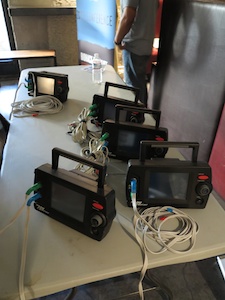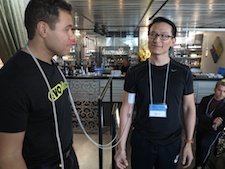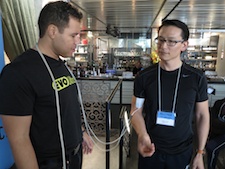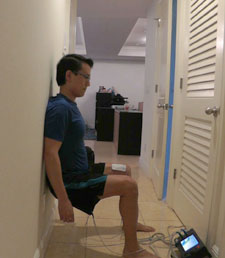For those of you swimming in Masters workouts and want to continue to incorporate TI learnings and principles, here are some tips:
General Tips:
1. Practice maintaining mental focus on each lap, to do whatever it is you are practicing for those lengths or laps.
2. Train your brain to keep active for the entire workout. Resist drifting off.
3. Practice counting strokes for each length, and remembering them by the end of the workout.
4. If stroke counting and other data you want to remember is hard, buy a waterproof notebook and waterproof pen from amazon and write things down. I would not recommend regular pen and paper. Paper will disintegrate upon contact with water, and regular pens won’t write on soaked paper.
5. Focus on continual improvement. Know when you are slipping or getting tired. Change your routine if it is getting monotonous.
6. Know when to get out of the pool. Our energy and skill ebb and flow day by day. Sometimes it’s better to just get out of the pool and – most importantly – do not keep imprinting bad swim habits for the sake of lasting through a workout.
7. Swimming has a energy system training component, but until your swimming skill has reached a decent level, it is more important to train the nervous system FIRST so that your body can make the correct swimming movements before you worry about extending perfect swim habits over time. Swimming poorly at higher stroke rates in an attempt to increase speed will result in exponential energy usage but with very little speed increase, or perhaps even decrease. It will also raise the probability of injury.
8. Training for short distance sprints versus for longer distance (ie. triathlon swim leg) versus for marathon swims (ie. swim around Manhattan) all have common elements and different elements. Don’t mistake the training that many coaches might do for pool swimming for optimal swim training for long distance.
9. Get to know your stroke counts at given tempos and lengths (ie. 25y, 50m). Take some time to setup a tempo/SPL matrix.
10. Having a Tempo Trainer (TT) means you can have consistency between workouts and know if your skill has increased or decreased day by day. Without the TT, it can be very hard to know if you’re really swimming better or not. Or if you’re having an off day.
11. Get used to swimming with the TT. It can be annoying/distracting/unfamiliar to be swimming to a task master like the TT whose beep forces you to swim to its tune, not to your own. I swim with the TT all the time now and can’t imagine swimming without it for workouts.
12. Get to know the Masters coach. Does he/she care if you break from doing his workouts exactly or does he come over to yell at you if you don’t swim his instructions? Does he let you not swim with tools if you want? Can you swim a set in freestyle even if he calls out back/breast/fly?
Are you able to ignore his instructions or yelling if he comes over and sees you not following your instructions exactly?
Does he comment on your little TT gadget and then make disparaging remarks about it? Or does he even comment on you “swimming TI” and how TI sucks?
It may be time to switch Masters workouts – your goal is to swim better, not to be berated for attempting to improve your swimming. IMHO a great coach should be open to new ideas and not be dismissive. In any case, unless you are specifically on a swim team driven by this coach, you should have more freedom on how you swim his workouts.
If you don’t have a TT, use these tips:
1. Before you start the workout, have a set of things you want to workout during the Masters workout. Generally, these boil down to focal points which will help you practice great swim form and habits.
2. For each interval, pick a focal point or set of focal points. Maintain the focal point for the entire length or lengths.
3. As you pause at the wall, select the next focal point, or keep you current focal point. You may want to practice the same focal point for many laps/lengths/intervals.
4. As your ability to swim with focal points increases, you can start trying to employ more than one focal point within a given swim set.
a. The first method would be to rotate between focal points, changing after each length. Ex. for a 150m lap, you would do focal point 1 for the 1st 50, focal point 2 for the 2nd 50, then back to focal point 1 for the 3rd 50.
b. A more advanced method would be to try to swim any given length while focusing on 2 more focal points at once.
5. Count strokes for each length. For TI, we like to count when the lead arm spears forward as one stroke.
a. Generally the first length seems to always be one stroke less. It is most likely the result of strong initial pushoff plus the length you are swimming with the most energy.
b. If you have a TT, we usually push off on a beep, let one beep go by while gliding, then pull one arm back on the 2nd beep, and our first official counted stroke is on the 3rd beep. This works for tempos of 1.2s or higher (or slower tempo). For faster tempo, we sometimes let another beep go by.
In general, you want to start stroking at about the same point in a pool length, which is usually around where the flags are. If you start stroking at different points in the lane, you’ll find your stroke count could vary by 1-2 on this fact alone.
If you have a TT, use these tips:
Use the tips for without the TT and combine with the below:
Warm Up Set:
1. Use the warm up set to determine your easy and cruise tempo for the day. It may be your usual easy and cruise tempos, or it may have changed due to other factors like fatigue.
2. Determine how many lengths or laps you can swim for your warmup. Start with your easy tempo. Aim to increase your tempo each length or lap until you hit your cruise tempo. So do some quick math and know the increment you want to increase tempo with, and adjust the TT after every length or lap.
Do not be afraid to not increase the TT if you are not feeling comfortable just yet. Swim another lap and see if adaptation occurs on this or the next length/lap.
If for some reason you’re just not able to increase it, you may have reached your current neural threshold. This is a data point for use later during the set.
3. You can use the warm up set to employ some focal points to fine tune your technique for the main set. This can also be a good time to see which focal points you need more work with, or less.
Main Set:
1. Get to know your tempos for the various effort levels a Masters coach might designate for a set. These might be easy, cruise, tempo, fast, strong, sprint, etc. These will also vary by length. Ex. you might be able to sprint at .7s tempo for 50m but you have a hard time sustaining that for 100m so you set at .8s.
Note this changes day to day based on fitness/fatigue level, and also as your skill grows.
2. Upon hearing the set, think quickly on the tempo(s) you will use, adjust the TT before you swim.
3. Depending on the set, you may or may not need to adjust the TT.
Sometimes you may go out too fast a tempo for a given set or fitness/fatigue level. You may need to pause at the wall to readjust tempo.
4. The easiest sets to swim with the TT are the ones that have a pause at the wall, which is time for you to be able to adjust the TT. So 3×50 descend 1-2-3 on 1:50 interval would have pauses between 50s to speed up tempo to aid in the descend.
The more difficult, if not impossible sets, are the ones that vary speed without you pausing at the wall. For example, a set which is 150s descending 50s would be tough to stop in between the lengths to adjust the TT. In situations like this, I would recommend one of two options:
a. Don’t adjust the TT. Just swim the entire 150 at one tempo. Note that this may cause yelling at you by the coach.
b. Set the TT at the starting tempo which is slower. Then attempt to “beat the beep” on the subsequent lengths. You could set it at the ending tempo but I find that it is more comfortable to start with the slower beep and then beat it on the subsequent lengths.
5. TI discourages the use of tools like fins and paddles. Depending on the situation, they have their uses. However, they do tend to interfere with developing the finer points of swimming that we teach. You should consider not swimming with them even during sets which require them.
6. If you are primarily a freestyle swimmer, consider free for sets that are back/breast/fly. You should essentially practice free as much as possible to get better at it. This may also result in a yelling session from your coach.
7. Over the time of a Masters workout, I like to end up at a faster tempo than when I started. This is because:
a. As my nervous system adapts, I can generally sustain higher tempos.
b. Pushing higher tempos challenges my neural threshold. My goal is to maintain form at higher tempos which in theory means I should be swimming faster.
c. Over the course of a race, you always want to end up either at the same effort level or higher by the end. Most of your competitors won’t have trained that way and will fizzle while you will be experiencing rising energy and, hopefully, speed.
So start with Easy->Cruise during Warm Up. Then start the first sets at cruise tempo and eventually end up faster than that, probably ending up at tempo which may end up being the new cruise tempo by the end of the workout, maybe even sprint tempo if the coach designates some sprints at the end.
8. Don’t increase tempo or back off to previous tempo if your nervous system isn’t adapting to the new tempo. Evidence is speed drop off, form breaks down, extra effort or discomfort experienced, etc. However, be patient. Try again in a set or two. Sometimes a little more time needs to happen before adaptation.
Having said that, if you just increased tempo and finding it tough to adapt AND you feel good still, try swimming a length or 2 or 3 at the new faster tempo. You may adapt after a few more lengths.
8. Be mindful of stroke counts and times to swim a length or lap. Practice using your brain to keep track of both as much as possible to know when your form is slipping. For example, a stroke count increase of 2 or more between lengths probably means your form faltered on that length, if the tempo remained constant. Another example: if you stroked at a faster tempo but your time to swim the length remained the same as with a slower tempo, was that a good set or bad?
Cool Down:
1. Simple method is to set it very slow and swim but with the same mindfulness. The aim is to swim technique-wise the same whether slow tempo or fast. But swimming slowly will cool you down.
2. Turn off the TT and swim slowly.
3. Practice minimizing stroke count with and without the TT.
4. Use focal points but with slower tempo for cool down.
Monthly Archives: April 2013
ARPWave and EVOUltrafit: Rehab and Training via Electrostim
In my journey to find the ultimate and most efficient training methods, I came across the next stop in my quest at Dave Asprey’s Bulletproof Conference back in January. There I met Dr. Justin Marchegiani of Just In Health and Jay Schroeder and Charles Maka of EVOultrafit.
Both of them specialize in using electrostim devices made by ARPWave to enhance treatment of muscle and movement issues and results in training. Yes, think Rocky IV where they had shots of Dolph Lundgren training with electrostim pads stuck to his chest! This is, of course, the real thing. Apparently, the Russians had pioneered the use of electrostim in training many years back. Now here with ARPWave, they have brought this to the public here in the US and it works great. Rather than attempting the long explanation of how it works, see the ARPWave How It Works description.
Dr. Justin is a chiropractor and nutritionist and he trained under Dr. Jay Pietila in his In-Balance system which uses the ARP devices to first determine where muscle imbalances are, and, then, to treat them. The In-Balance Technique can evaluate “neurological signaling from the brain to the body” and determine if they are balanced via strategic placement of the electrodes and moving them around the body. Injuries and rehabilitation can both also be done with similar methods.
I went to Dr. Justin for several treatments and it was fascinating to see him probe my body with the electrodes, sometimes seeing myself jump in reaction. These were areas of concern and showed dysfunction and imbalances. He then stuck electrodes on those areas, turned up the power, and then had me do movements. With the power cranked, compensation patterns appear and I was forced to do the movements correctly, without compensation patterns and fighting through the intensity of the electrostimulation (see more info on ARP Therapy). The sessions were so intense that I had delayed onset muscle soreness for days after! Not sleeping enough, nor eating enough didn’t help my recovery. But after about the 3rd visit, I started seeing some great results.
For example, I had a nagging problem with my TFL (Tensor Fasciae Latae) muscle, a small muscle on my hip. It always seemed to be firing and was taut all day long, which is pretty annoying. I tried everything to get it to calm down but nothing really worked. With Dr. Justin’s probing, we figured out that it was not the TFL but my Sartorius muscle, which attaches in the same place as the TFL. He hooked that muscle up, stimmed the hell out of it while forcing me to walk in place and do squats. Soon after (well, after the soreness went away!) I didn’t feel my TFL/Sartorius any more!
Around the same time, I began a training program with Jay and Charles at EVOUltrafit. And of course I had to own one of these electrostim bad boys myself – so I plunked down some cash to get one and wanted to see if training the EVO way would help rid myself of some nagging problems I’ve had, like cramping out in the last half of marathons. But also, according to Jay and Charles, the use of the electrostim machine not only prepares me physically for athletic pursuits, it also stimulates my CNS (central nervous system) and all sorts of other things start to work better, like my glands, hormones, digestion, cognition, and thinking. I didn’t care about the cost – this sounded like the answer to all my problems all at once! I bought one of their POVsport devices, which is the consumer version of the electrostim devices.
 Jay Schroeder |
 A table full of POVs! |
 Charles Maka hooking me up |
 Compensatory action! |
I submitted a thorough evaluation. I ran set distances, and did some physical tests. I also submitted videos of me doing some typical workouts. It wasn’t pretty. They wanted to see me hop on one leg, on two legs, sprint some distances – pretty bad since I hadn’t done anything for months!
They came back with a program that uses what they call “isoextremes” which are isometric hold type exercises. The four I started with are:
1. Standing Push Up
2. Wall Squat
3. Scapular Pull Up
4. Lunge
 Me doing a wall squat hooked up with electrodes |
The way these exercises are done aren’t probably the way most people think they are done. For example, the lunge is not an exercise which works the quads; instead, you are supposed to pull the lead leg into a leg curl via the hamstrings, and the rear leg is supposed to have tension pulling it back and upwards. Many of these isoextremes seek to teach the body how to lengthen muscles which may normally think we’d want to tense up in order to do the isometric exercises. It also seems that these isoextremes also train the nervous system to react in the proper way to movements and absorbing force – somehow they have found that holding static positions can train the nervous system to act while moving. Pretty cool stuff!
They gave me specific electrode placements based on issues they saw in the videos. Being experienced coaches/trainers/therapists, they didn’t need to see me live; they could pick out all my problems just by looking at my doing some movements. While the isoextremes can train me by doing them alone, they are more effective when combined with a POVsport unit and proper electrostimulation of the right muscles.
I then proceeded to train on their protocols. Before each workout, I would “loosen” using the POVsport. Depending on the settings, the POVsport can cause muscles to be conditioned or loosened – the waveform it generates is patented and is not like other electrostim units. I was skeptical at first but loosening works pretty well. The stim magnifies your normal loosening movements and helps warm up the body while causing muscles to release their tightness.
Each movement is about 8 minutes in duration, doing 1 minute of work with a minute of rest. At first, they were pretty unfamiliar and difficult. Adding the electrostim coursing through various muscles didn’t help as my muscles were thrumming at many many times per second. In the power output of the POVsport, level 100 is the level at which the body, it it can tolerate it, will experience no compensatory patterns at all. So a goal is to get to power level 100 at some point.
I also joined up with their monthly webinar series. The first one was interesting – it’s an hour of discussion and teaching through personal experiences with the POV via protocols that Jay/Charles give us, and then we observe the results after about a month. Fascinating stuff and I think necessary to really learn how to get the most out of my POV. Hooking electrodes up yourself without direction is a pretty dangerous thing – there are stories of people overloading their CNS accidentally and throwing them into a state of “restoration” which means they are mimicking a state of severe sickness and weakness! Bad news. Think I’ll walk slowly and with lots of direction….
What results after about a month of EVO training?
Some tightness – my body has a “fear” reaction to this foreign stimulus of electrostim and seems to cause some tightness in their overnight protocols while sleeping. But I switched to another one they gave us during the webinar and the tightness went away!
Some of the results were masked by me getting conjunctivitis and a spring time allergy attack. Also lack of sleep from new young kids in the house doesn’t help. But on days when I do get a good sleep, I can see a marked increase in ability – I think my resources get too tied up with managing the lack of sleep mostly and also the occasional malady that has hit over the last few weeks.
Interestingly enough, my deadlift movement has a new feeling. Before EVO workouts, I would deadlift my kids off the ground for practice, or my kettlebells or barbells and have to clench my glutes or “close off my sphincter” to make sure I am getting proper posterior chain activation. But after I started EVO training, all of a sudden I was feeling both glutes AND hamstring activation, which is better and exactly what I want! This is an awesome result.
Some of the lengthening aspects of the isoextremes have also worked well. On the standing push up, I can nearly relax my pecs so much and get them to lengthen upon contraction of my lats so much that I can nearly pull myself through a doorway. The wall squat seems to have gotten easier but it’s still a willpower challenge. Hanging from the scapular pull up, I can lengthen my lats quite a bit, but my grip suffers a ton. Charles tells me this is natural although I wish my grip were better. The lunge seems to be working on one side better. I can really flex my glutes/hams on my left side (left leg back, right leg forward) to lengthen my hip flexor and quads, but not so well with my right leg back.
The whole thing is fascinating as an experiment in using an external device to help with my training and improving aspects of my physical condition. I am looking forward to further training with the POV unit to accelerate training and fitness, and to run a marathon without cramping!